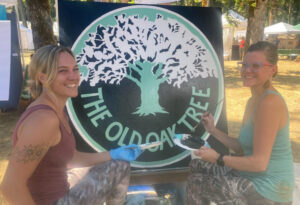By Melissa Wagoner
There is no symbol in Silverton’s history more iconic than that of the “Old Oak Tree,” a meeting place initially for the Native tribes of the Molalla and Santiam area and eventually for the white homesteaders who settled here.
“The old oak, as everybody called it, was a stately giant, and the early settlers of Silverton looked a fitting people to group themselves under it and around it…” Homer Davenport wrote in the introduction to his book, The Country Boy in 1910.
Cut down in 1893 in order to make way for the expansion of the town, its death was lamented by Davenport who viewed its removal as a symbol of the modernization to come.

“My only regret is that we couldn’t have remained always the same as we were before the big oak tree was chopped down, as that tree seemed to fit into our landscape better than open or paved streets do,” Davenport wrote. “The tree seemed to be a center of dignity around which we could build, a tree with stories beyond the first white man it ever saw; and many a day when I have watched the leading citizens playing marbles in its extensive shadow, I have thought: How many are the interesting stories you could tell, of ages passed when you saw the beautiful deer and other wild game gather at your base.”
The community remembered the tree, too. It was first memorialized in 1966, when its stump was excavated and moved to Old Mill Park; then again in 1995 when artist Lori Rodrigues painted The Old Oak Mural on the west side of what is now Citizens Bank. Finally, the tree’s original location was marked in 1998 when artist Theresa Sharrar painted a simple visage of the tree directly on the street.
“The importance is remembering where the tree actually stood,” Silverton Mural Society member Kali Dirks said describing the emblem’s importance and why, on Labor Day weekend of this year, she and fellow muralist Tonya Smithburg refurbished the painting, which had become almost entirely unrecognizable.
“We restored it six or seven years ago but we didn’t do as much,” Dirks recalled. “But this time we sprayed the street, scrubbed it and put on oil primer.”
Spare in its design, the Old Oak Tree emblem was actually one of the easier murals the duo is slated to repair this “mural season” – essentially the warm, dry summer months – but that doesn’t mean the job was entirely without its challenges.
“We blocked off four parking spaces and then Norm [English, a Mural Society Board Member] sat out there with his red vest,” Dirks said, describing the scene, which included the two artists kneeling in the road while cars zoomed by. Much the way Sharrar did when painting the original.
“It’s hard on your body because you’re in very awkward positions,” Dirks added. But, eight years in, it’s also something she enjoys.
“It’s always mattered to me,” Dirks said, recalling the day when, as a child, she watched muralist David McDonald painting the original Four Freedoms Mural.
“I watched him paint it and I thought it was actually Norman Rockwell,” she laughed.
The scene made an impression and now, many years later, it is she who is painting original pieces, including a new one slated for this winter that will feature Dr. Olwyn Davies, who practiced medicine for over 65 years.
“He really served the Silverton community,” Dirks said. “And he delivered lots of babies.”
Smithburg, too, will be producing a new mural, this one of the Fischer’s Flour Mill, which will bring Silverton’s mural count to an astounding 33, a number few cities of Silverton’s size can boast.
While maintaining this number has been historically difficult for the mural society, it is their way of keeping Silverton’s history alive through art – something Davenport strove to do as well, through both his cartoons and his prose.
“To me the old oak tree always stands and under it the men play marbles,” Davenport wrote. “The pioneers and their families that made it so full of character are still in their prime of life, the first beautiful girl I ever saw is still there just as beautiful as ever, and in the streets I yet hear the latest marches by the old Silverton band, the stores are still aglow with rich beauties. That’s why I love it so dearly and that’s why it’s yet home to me.”